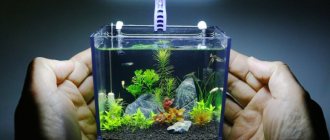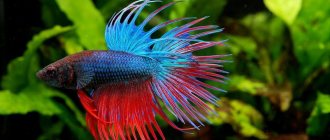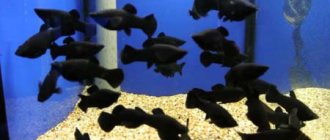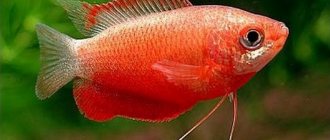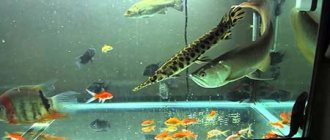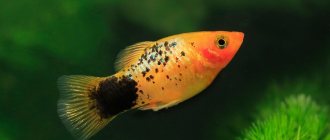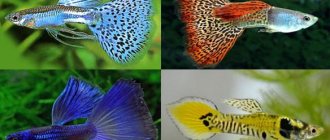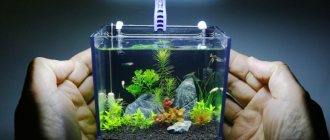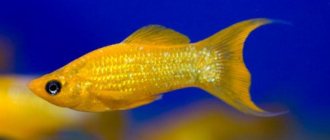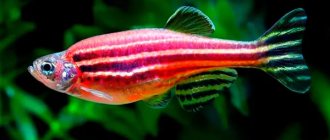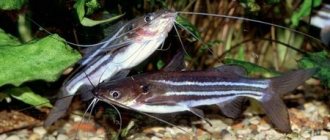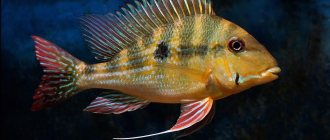Those who dream of the first aquarium in their life usually imagine a 20-25 liter tank. Beginners think that this is the optimal size in which they can easily create their own underwater world. There are those who, for some reason, really can’t afford to have a large aquarium at home. Sometimes unpretentious aquarium fish are vitally needed. And there are also aquarists whose goal is to maintain a nano aquarium with small fish. All this is quite real. In pet stores you can find aquariums for beginners, unpretentious fish for a small aquarium, and even special devices for creating a truly correct biotope.
Small home aquarium: rules
Even small fish require attention and careful treatment. It is more difficult to create good conditions in a 10 liter aquarium than in a 100 liter tank. Useful information for a beginner - basic requirements for a home aquarium:
- Pure water. There should be no objects in the water that release harmful substances into the water.
- Compliance with parameters. Even the smallest aquarium fish cannot live in very alkaline or overly acidic environments, high in chlorine or nitrates. Hardness, acidity - all this will have to be checked regularly.
- Compliance with fish requirements. If the fish needs soil at the bottom, it should be there. If the fish does not need aeration, then the beginner is lucky and there is no need to install a compressor.
- At least minimal care. Like any animal, fish for a small aquarium will still require attention from you: for example, regular water changes.
- It is especially difficult to maintain temperature in small aquariums. You will have to carefully monitor the water temperature.
- It is equally important to ensure that there is no overcrowding in the nano aquarium. Compatibility is the most important parameter when choosing.
General requirements
Due to the tiny volume of the container, not all aquarium inhabitants are suitable for you.
Therefore, you should pay attention to the following criteria:
- Small size. Acceptable body length is 2-6 cm.
- Calm, peaceful character. A lonely fish will certainly get bored, its color will fade, which is why it is recommended to keep aquatic inhabitants in schools, even in small containers.
- Unpretentiousness. It is not easy to create ideal conditions in a 10-liter container, so exotic varieties with a whole list of necessary maintenance rules will not work. It is advisable to choose hybrids; they have stronger immunity.
- Bright color. The criterion is not as important as those previously indicated, but the beautiful colors and shades of scaly bodies will help create an amazing mini-composition, a true work of art.
Small fish for the aquarium: top 10 popular species
- Sumatran barbs. Live, active fish that need strong currents. Therefore, when setting up an aquarium, it is important not to forget about the filter that this current will create. Good conditions - an aquarium of 30 liters per flock. It would be better if the aquarium was larger. Barbs feel better in cool water; this is very difficult to organize in mini-aquariums.
- Catfish Corydoras (speckled). Small, unpretentious fish that live mainly on the bottom. They do not need additional air, since they have “gut respiration” and do not only breathe through their gills. Peaceful, calm and positive fish that will become good neighbors to other representatives in an aquarium with a volume of 30 liters or more.
- Platies are creatures that are quite tolerant of poor conditions. Unlike colored fish, guppies have a restrained color scheme and a somewhat combative disposition. They easily fit into aquariums from 30 liters, but they prefer larger tanks. If there is overpopulation, they can start a war. Often in small aquariums they coexist with small catfish.
- Lemon tetra. Grows up to 4 cm, loves a flock of its own kind. Undemanding to conditions and easy to care for and maintain. Bright, and with the right lighting it becomes irresistible.
- Gourami and lalius. They are labyrinthine, which means they have a special breathing system that allows them to do without aeration. For small aquariums this is very important, since it can be very difficult to place a compressor in 20-30 liters.
- Guppy. Perhaps the most popular fish, which is known not only to beginners, but also to people who are generally far from aquarium hobby. Male guppies are brightly colored, with lush fins. Females are larger, but less attractive. Guppies are peaceful and viviparous; under good conditions they can reproduce spontaneously. The optimal volume is at least 20 liters for 5-6 fish. They have an accommodating character, but in a close group they can become unattractive and often get sick.
Interesting fact: despite the fact that we tend to take guppies lightly, there are true connoisseurs of this species. They strive to have rare and unique breeds and spend considerable sums on this.
- Cardinal. Like guppies, male cardinals are brighter than females, but in principle, fish of both sexes look good in a small aquarium. They need a flock of their own kind - at least 12-15 pieces. Calm and cheerful fish that reproduce successfully given suitable conditions. The aquarium for such a flock should be from 40 liters.
- Iriaterina Werner. A fish up to 6 cm in size, with large beautiful fins. Requires an aquarium of 30 liters for 2-3 pieces. Very demanding on water parameters.
- Notobranchius Rachova. The males of these fish are incredibly bright orange-blue. For one family of 2 fish, a capacity of 20-25 liters is enough. But they are demanding on parameters and temperature (they prefer cool water).
Definition
A small aquarium is considered to be one with a volume of no more than 50 liters and a length of 20-40 cm.
Nanoaquarium is a container with a capacity from 5 liters to 20 liters. You shouldn’t think that its tiny size makes it easier to care for; in fact, keeping such a “crumb” clean and tidy is much more difficult than dealing with a traditional format. The advantages include affordable cost and the ability to install in a small room. Most often the models are cubic or rectangular.
A small amount of water inevitably leads to a serious problem - even the most minor changes immediately affect the health of its inhabitants.
Equipment and arrangement
A small tank should be prepared for the settlement of aquatic inhabitants no worse than its large “brother”.
Before purchasing fry, make sure you have:
- LED lamp that does not heat the water;
- filter of sufficient power;
- compressor;
- heater (preferably with a thermostat);
- plants that are suitable in size, for example, dwarf anubias;
- decor
Beginners may want to consider a fully stocked aquarium that comes with everything they need already installed (such as the Dennerle Nano Cube).
Important! The filter is especially important for a small tank, where any change in equilibrium can lead to the death of all inhabitants. It must pass at least 8 liters of water per hour, have a large filler surface and have water intakes that prevent unwary fish from getting into.
Fish for nano aquariums
Nano aquariums include tanks of 4 liters, 5 liters and up to 10 liters. In themselves, such home aquariums are very convenient: they become a desktop decoration along with family photographs and stationery. But in order for the fish to live happily ever after, the microaquarium must be taken care of especially carefully.
- Cockerels. It is believed that this bright fish with lush fins and amazingly beautiful color can live in a glass of water. Of course, this is a misconception; one individual should have at least 4-5 liters, and optimally 7-10 liters. If you want the fish to be happy, a male betta needs a 30-liter aquarium and 2-3 females. Two males definitely won’t get along in a mini aquarium.
- Neon. One of the smallest fish for an aquarium. In theory, several individuals will be fine even in a volume of 10 liters. But neons can hardly be called unpretentious. They prefer to live in flocks of 10-15 pieces, and for such a number they need a tank of at least 40 liters. In addition, neons, like striped zebrafish, are demanding on water parameters. Neons rarely get along with other fish - they are defenseless.
- Danio. They are similar in size and behavior to neons, but do not need a large flock. Appearance – longitudinal dark stripes on a light background. There are also spotted and red ones. They have a wide temperature range (from 15 to 30 degrees), but like all living aquarium settlers, they do not tolerate sudden changes.
- Micro-assortment. Perhaps the most unpretentious aquarium fish for a small aquarium, they grow up to 2 cm. Only 1 liter of water is required per individual, so a mini-flock can be comfortably placed in a nano-aquarium. They look especially good in aquariums filled with living plants and mosses (aquascape), which is done by nano-aquarium professionals. But a beginner who wants to learn aquascaping can start with a small tank.
- Blue-eyed Norman. If you organize the right lighting, the fish will sparkle with amazing neon shades: this is how the eyes of small fish will glow. The size of each individual is 3-4 cm. Playful, active, they are successfully placed in aquariums of 15-20 liters.
- Tetradon dwarf. A rare fish so far, bred specifically for small containers. For a couple of fish, 10-15 liters is enough. But the tetradon is a rather aggressive fish that can start a war for territory, so if possible, it is better to find a larger container and equip it correctly.
- Tetra amanda. Several fish 2 cm long can live in a tiny aquarium, however, tetra is a schooling fish, so the best option is a 30-40 liter tank and a school of 6 pieces. They require good filtration: the water must be clean.
- Neoheterandria elegans. While a little-known breed, it has a bright brindle color and an unpretentious character. For a couple of fish measuring 2.5-3 cm, 10 liters of water is enough. Good fish for beginners, there is one drawback: they are still difficult to find on sale.
- Tetra elahis. Also a rare little one, up to 2 cm in size. It has a soft blue color with spots in the tail area. Prefers to be kept in a flock. For 3-4 individuals you need an aquarium of 20-30 liters, and a full-fledged comfortable flock of 6-8 fish will require an “apartment” of 30-40 liters.
- Formosa. Very easy to maintain, does not require any special conditions, and an aquarium is suitable from 12 liters. Outwardly it resembles neon, but is somewhat smaller in size.
Origin
“Domestic” fish first appeared in China around the 13th-14th centuries. It was during this period that goldfish began to be bred in the monastery ponds, which gradually changed, acquiring a bright color, but a smaller size.
At the beginning of the 16th century, the idea of populating artificial reservoirs spread in Korea, then in Japan. The Japanese made a special contribution to the development of species - they created new varieties that differed in both size and color. Nowadays, the inhabitants of aquariums differ in shape and color; among them there are owners of bright scales that glow in the dark. Some lovers of the aquatic world prefer to observe the bizarre behavior of real giants. And other aquarists opt for small biotopes.
What kind of fish to get and how to combine them in small quantities
Aquarium 4-5 liters: it is better to leave without live fish, you can limit yourself to just a beautiful design.
Aquarium 10 liters:
- 1 cockerel;
- 3-4 cardinals
- 4-5 guppies or Endler’s guppies (these are natural individuals, they are even smaller than the ones we are used to, bred by breeders);
- 4-5 neons;
- 4-5 Norman blue-eyes;
- up to 10 microdigestions
It is better not to combine several species in such a tank: the schools will be too small, and the fish will not live happily.
Aquarium 20 liters:
- 1 male cockerel with 2-3 females;
- 12-15 guppies;
- up to 20 zebrafish or neons;
- 5-7 cardinals;
- 10-12 happy neons;
- up to 20 microrasbor.
Can be combined:
- 5 guppies and 5 zebrafish;
- 10 guppies and 2 speckled catfish;
- 7-8 neons and 2 speckled catfish.
30 liter aquarium:
- 4-5 barbs;
- 2-3 apistograms;
- 12-15 cardinals;
- 20-25 neons or zebrafish;
- 2-3 macropods;
- 2-3 Werner's iriaterina;
- 10 analysis
30-40 liters is considered ideal for a beginner. It is convenient to observe the behavior of fish, track diseases and organize feeding.
Other families
Acantophthalmus
Cute fish with a serpentine body up to 10 cm in length. They belong to the loach family. They spend time searching for food among the soil and help in cleaning the aquarium. We recognize it by its yellow-brown color in the form of rings encircling the body. The absence of scales makes acanthophthalmus vulnerable to medicinal drugs. Popular types include kuhl and myers.
How long do fish live in small aquariums?
A pressing question, especially for beginners. Small fish rarely survive beyond the age of 2 years. Just open and read the description of any small fish. It indicates the maximum lifespan in captivity, with proper nutrition, lack of stress and good care. If the conditions are unsuitable, the fish live even shorter. Their condition is negatively affected by:
- Dirty water;
- Overpopulation;
- Wrong food;
- Lack of vital facilities (shelters, living plants, soil, aeration, filter);
- Constant stress;
- Incorrect temperature;
- Infections introduced with dirty equipment or new fish. If someone gets sick in a small aquarium, the infection is likely to spread to all the inhabitants, including catfish.
The smaller the aquarium, the less suitable it is for keeping living creatures. Therefore, nano-aquarium is considered a difficult task. However, small home aquariums of 30 liters are quite suitable for beginners: they can accommodate quite a lot of unpretentious fish, be beautifully decorated and equipped with a filter and compressor. Don’t forget that even a small aquarium requires regular maintenance: cleaning the soil, walls, and water changes.
Recommendations
Choose an aquarium with the largest volume of water you can find room for. Any home aquarium that cannot be fitted with a filter or heater must be handled with great care. For example, it is difficult to install any equipment in a small round aquarium. And such a container will need special care. In a separate article you can read “How to care for a small round aquarium.”
It is better to find a small but fully functional aquarium. There are many of these on sale, small in size, and with all the necessary equipment: lighting, filter, heater and primer. You can even find micro aquariums from 7 liters in volume with a full set of everything you need.
Microassortment of erythromicron
The name of these little ones speaks for itself - their size is no more than 2 cm. Microrasbora erythromicron is almost as popular as microrasbora galaxy, and almost as attractive. It is better to keep this species in a school; for 15-20 fish, an aquarium with a volume of 35-60 liters is enough. It is recommended to keep fish in a group and in a large aquarium due to the warlike dominant behavior of males. It is not recommended for beginners to keep these fish, since the water in the aquarium with them must be crystal clear.
Cherry barb
The cherry barb is a calm, peace-loving fish. The size of adult individuals does not exceed 4 cm. The color is cherry-red, a narrow black stripe runs along the body, and the back is brown.
Cherry barbs are kept in groups of 6 or more in aquariums with a volume of 50 liters or more. Fish prefer a temperature of 22-24°C, pH 6.5-7 and dH up to 15°. Cherry barbs love tanks filled with plants and dim lighting. In bright light, barbs become shy and hide in the thickets most of the time. Cherry barbs prefer old water; Once a week it is necessary to replace no more than 1/5 of the volume. Live and frozen food (daphnia, cyclops, bloodworms), dry feed mixtures and plant supplements are suitable for feeding.
Cardinal
Cardinals are unpretentious, peaceful fish. The body size of representatives of the species does not exceed 4 cm. The body is brown, the belly is light, the mouth, tail and fins are red, on the side there are two longitudinal stripes - a shiny bluish-orange and a black one underneath.
Cardinals are kept in flocks of 5 or more individuals in aquariums with a volume of 40 liters or more. Fish prefer water with a temperature of 22-25°C, pH 6.5-7 and dH 20°. Cardinals love bright lighting and planted ponds, stay in groups mainly in the middle layers of water and are not inclined to hide. The aquarium must be equipped with a filter and an aeration system. Cardinals are non-aggressive and are suitable for a community aquarium stocked with peaceful species of similar size.
Labyrinthine
A distinctive feature is the structure of the respiratory system. They breathe air and regenerate well. They do not need aeration. It is important to provide access to air. This is why they are often called fish that live without oxygen.
Macropod
Aquarium fish up to 10 cm in length with a memorable appearance. Known as paradise fish. The caudal fin of the macropod fish is distinguished by its large size and pointed shape. The scales shimmer in the light, adding shine. Aggressive and cruel, but at the same time caring parents.
Cockerels
The species have multi-colored veil fins. Body length 6 cm. Demanding about the purity of water, otherwise unpretentious. Take care of compatibility with your neighbors. Betta fish are aggressive towards smaller fishmates, cichlids and other predators. Intraspecific conflicts between males are not uncommon.
Red-nosed rasbora (sawbwa)
Another small but attractive aquarium fish, up to 2.5 cm long. It is surprising not only for its size, but also for its color: the nose and tips of its tail are bright red. Fish love to live in schools, but a 35-liter aquarium is enough for a group of these little ones. However, this fish is not for beginners - it prefers clean water, so it needs regular care.
Danionella dracula
Danionella dracula is a small fish, the distinctive feature of which is its lower jaw extended forward. In males, it has a pair of long teeth protruding beyond the oral cavity, which is how the species got its name. The size of adult individuals does not exceed 1.5 cm. The body is transparent, internal organs are visible through the skin. A yellow stripe runs along the body at the level of the spine, and the head is also yellow.
Danionella are kept in groups of 10 individuals in aquariums with a volume of 40 liters or more. It can be kept together with other species of similar size. Danionella thrives at a temperature of 20-26°C, pH 6.5-7.5 and dH 2-5°. The species does not like bright light and strong currents. Danionellas are fed with any food of suitable size.
Dwarf Corydoras (Pygmy, Hastatus, Habrobus)
It is also advisable to supplement nano aquariums with bottom inhabitants, which will help clear the bottom of food debris and create movement in the lower part of the aquarium. Dwarf corydoras are ideal for this, because the largest size they can grow to is 2-3 cm. These are the smallest known aquarium catfish. Please note, however, that these species love oxygenated water, good currents and room for swimming, so it is still recommended to take a larger aquarium for them.
